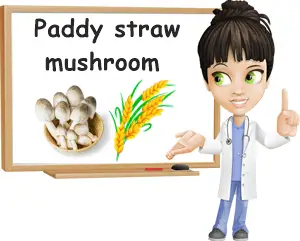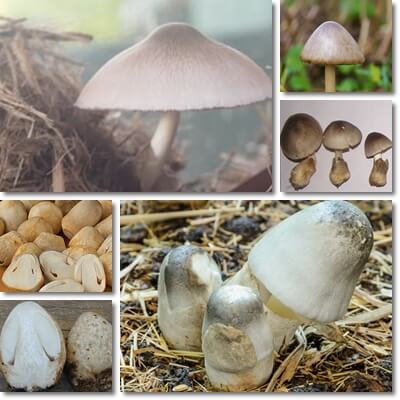Paddy straw mushrooms, more simply called straw mushrooms, are a species of edible fungi cultivated in rice straw. Paddy straw mushrooms go by the scientific name Volvariella volvacea and are popular in Asian cuisine where they are considered a culinary delicacy. Outside their areas of cultivation, they are not available fresh, only dried and canned. Paddy straw mushrooms are known to be a good source of vitamin D2 and protein and low in calories. As for their benefits, they have been found to contain polysaccharides with antitumor activity and lectins with immune system modulating properties.
What are straw mushrooms? The name straw mushroom may refer to various species of edible mushrooms grown on rice straw or other cereal straw-based substrates, including wheat. Alternatively, banana or plantain leaf bedding, cotton, sugarcane or wood waste, corn husks and other organic substrates may be used, either alone or in combination with rice or other cereal straw. More specifically, straw mushroom refers to Volvariella volvacea, a species of edible mushroom cultivated extensively throughout Asia.

Volvariella volvacea grows naturally on fermented or composted rice straw bedding. Moreover, rice straw is the best substrate for producing paddy mushroom spawn, either alone or in combination with other substrates. As a result, the species is also called the rice paddy, paddy rice straw or paddy straw mushroom. Other common names include the Chinese mushroom, suggestive of its cultivation in 18th century China. Straw mushroom spawn are available for sale for anyone interested in the cultivation of the species.
What do paddy straw mushrooms look like? Volvariella volvacea is commonly harvested while still immature, after roughly 4 to 8 days of mycelium growth. At the stage at which it’s preferred for consumption, the mushroom still has an egg-like or button-like appearance. The cap and stalk, although formed, are enclosed in a thin veil which is what gives the overall egg or button-like shape to the mushroom. Veil color is a mix of whitish-grey and tan or yellowish brown, usually darker towards the center. As the mushroom matures, the veil breaks open and reveals a typical fruiting body: an umbrella-shaped cap supported by a slender-looking stalk. The cap is a mix of white or tan and a darker grey-brown center, while the stalk is whitish or tan. In adult specimens, the only remnant of the veil is a cup-like structure at the base of the stalk called a volva.
Look alikes. At the stage at which it’s typically harvested for consumption, the paddy straw mushroom looks a lot like the poisonous Amanita phalloides, commonly known as the death cap mushroom. One major difference between the two species is the spore print color: A. phalloides has a white spore print, whereas the edible Volvariella volvacea has a pink spore print. However, it’s extremely easy to mistake one species for the other when foraging – although their areas of distribution do not normally overlap, amateur foragers may not know exactly which species grows where. As such, it’s best to get your paddy straw mushrooms from the supermarket, health food stores, ethnic food stores, the Asian market or local farmers – all sources that can provide some form of certification as to the edibility of the product.

What do paddy straw mushrooms taste like? Fresh paddy straw mushrooms have a pleasantly tender and smooth flesh and a particular taste with rather unique flavors. The flavor profile includes dark, meaty, savory aromatic notes and several peculiar flavors, including faint musty and even metallic flavors. Dried paddy straw mushrooms are stronger-tasting with a more intense flavor compared to fresh ones which have a moderate taste intensity. Canned ones have the least flavor and a slimier mouthfeel – these need to be drained and rinsed before use and the water they’ve been kept in discarded. Paddy straw mushrooms are preferred ‘unpeeled’ or ‘unopened’ (before the cap erupts from the veil). At this stage, they are reported to be the most flavorful.
Nutritional information
Nutrition facts of dried paddy straw mushrooms (values for 100 g):
Energetic value: 286 kcal (kilocalories)
Protein: 28.5 g
Fat: 0 g
Total carbohydrates: 42.8 g
Sugars: 0 g
Fiber: 14.3 g
Iron: 64.3 mg (milligrams)
Sodium: 71 mg
Nutrition facts of canned paddy straw mushrooms – drained solids (values for 100 g and 1 cup servings at 182 g a cup):
Energetic value: 32 kcal per 100 g and 58 kcal per cup/182 g
Protein: 3.8 g per 100 g and 7 g per cup
Fat: 0.7 g per 100 g and 1.2 g per cup
Total carbohydrates: 4.6 g per 100 g and 8.4 g per cup
Sugars: 0 g
Fiber: 2.5 g per 100 g and 4.5 g per cup
Calcium: 10 mg per 100 g (18 mg per cup)
Copper: 0.133 mg (0.242 mg)
Iron: 1.4 mg (2.6 mg)
Magnesium: 7 mg (13 mg)
Manganese: 0.098 mg (0.178 mg)
Phosphorus: 61 mg (111 mg)
Potassium: 78 mg (142 mg)
Selenium: 15.2 mcg (micrograms) (27.7 mcg per cup)
Sodium: 384 mg (699 mg)
Zinc: 0.67 mg (1.2 mg)
Vitamin A: 0 mcg
Vitamin C: 0 mg
Vitamin B1: 0.013 mg (0.024 mg per cup)
Vitamin B2: 0.070 mg (0.127 mg)
Vitamin B3: 0.224 mg (0.408 mg)
Vitamin B6: 0.014 mg (0.025 mg)
Vitamin B9: 38 mcg (micrograms) (69 mcg)
What are the benefits?
Paddy straw mushrooms can be a source of health benefits when consumed in reasonable amounts, as part of a varied and balanced diet. The species can encourage the following health effects:
1) Supports healthy weight loss – thanks to a low energetic value and good amounts of dietary fiber and protein which promote satiation and curb hunger.
2) Benefits for digestion: dietary fiber regulates transit time and helps relieve constipation.
3) Good for building and repairing muscle thanks to a high protein content: 38% protein.
4) Combats fatigue and restores vitality thanks a good iron content (around 14% of the recommended daily intake, RDI in a cup of canned paddy straw mushrooms).
5) Stronger bones and teeth from a good phosphorus content (a cup provides around 10% of daily phosphorus requirements).
6) Supports thyroid health for better metabolism and improved fertility (one cup of canned paddy straw mushrooms provides about 40% of daily selenium requirements).
7) Antioxidant, anti-aging and immune-boosting properties as well as benefits for hair and eye pigmentation, bone and thyroid health from good amounts of copper (roughly over 10% of RDI per cup).
8) Good food to eat during pregnancy thanks to a good vitamin B9 (folate) content – over 15% of daily requirements in a cup of paddy straw mushrooms.
9) Benefits for the immune system from zinc (almost 10% of daily requirements per cup), vitamin D and lectins with immune system modulating properties.
10) Source of polysaccharides with antitumor activity – polysaccharides from the species elevated interferon-gamma (IFN-γ), Interleukin-2 (IL-2) and Interleukin 12 (IL-12) levels, activating the immune system against tumor cells.
Side effects and contraindications
There are actually fewer side effects associated with consumption of paddy straw mushrooms compared to other species. First of all, they are a commercially cultivated species and not foraged from the wild. This alone means there is no risk of confusion with inedible or poisonous species. And given that they are grown in a controlled environment, the risk of heavy metal contamination is greatly reduced (depending on the choice of substrate). However, it’s important to consider the following aspects:
1) Gastrointestinal side effects. Some people experience gastrointestinal upset after eating the mushrooms and may experience side effects such as upset stomach, abdominal cramps, loose stools or diarrhea. If the mushrooms are foraged from the wild, it may be worth considering the possibility of having mistaken Volvariella volvacea for potentially inedible or poisonous species such as A. phalloides.
2) Allergic reactions. Although rare, it is possible to experience symptoms of an allergic reaction after consumption of various mushroom species. Seek medical help immediately in case of: hives, wheezing, coughing, difficulty breathing, swelling of the tongue, throat or lips, laryngospasms, asthma episodes, low blood pressure, fainting or gastrointestinal symptoms.
3) Contamination with arsenic. Rice naturally accumulates the metalloid arsenic from the surrounding environment. Mushrooms accumulate contaminants from the surrounding environment as well. If grown on a rice bedding (rice straws with bran or husk), paddy straw mushrooms may accumulate arsenic from the substrate and/or water use to prepare the substrate. However, reasonable consumption of the species does not represent a source of side effects.
